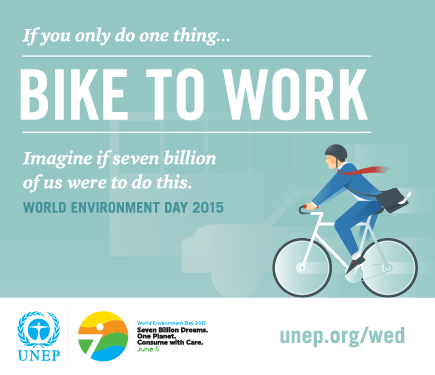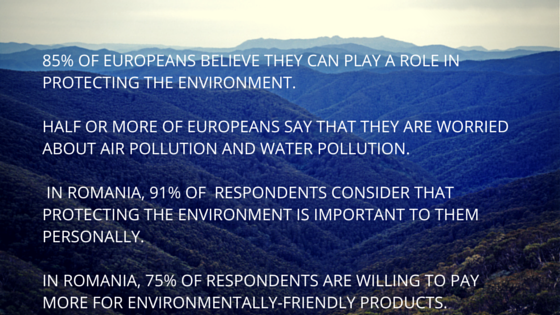Today we celebrate World Environment Day, a day in which we all receive a multitude of messages that promote awareness and action for the environment. This year, UNEP, the organization that initiated this movement, encourages people to do one thing for the environment that could generate a big positive impact when multiplied by 7 billion people. Recycling, biking to work or decreasing the consumption of meat are some of the actions promoted by UNEP’s campaign.

But how will people respond to these messages? With just a like and a share? Or will these messages influence people's behavior, leading to the adoption of pro-environmental actions?
The answer has to do with the ,,value-action gap”.
What is the “value-action gap”?

Source: Special Eurobarometer, ATTITUDES OF EUROPEAN CITIZENS TOWARDS THE ENVIRONMENT, 2014
While the percentages above may seem very positive, making us believe that our environment is in really good hands, unfortunately, people do not always behave in line with their values regarding the protection of environment, often failing to practise what they preach. This gap between people’s concern about the environment and their concrete actions is called the “value-action gap".
How can we reduce this gap between people’s positive values and attitudes towards the environment and the willingness to actually do concrete things?
Here are 5 potential strategies that could be taken into consideration by environmental non-profit organisations, communicators, campaigners, businesses, PR & advertising agencies etc.:
1. We need to tackle the ‘structural constraints’
In some cases, the lack of action despite people’s pro-environmental values is caused by ‘structural constraints’. For instance, even though a person is willing to reduce its carbon footprint, the lack of efficient public transport infrastructure or functional bike lanes in a certain city may force that person to use the car for going to work.
A quite surprising ‘structural constraint’ is related to our working conditions. A recent study shows that people who work longer hours tend to have a bigger gap between their concern about the environment and their actual engagement in environmentally friendly actions.
So, we need to start promoting and encouraging work-life balance, in order to make room for environment in people’s lives.
2. We need to work with people’s values
In order to systemically address sustainable development issues, there is a need for understanding the current public behavior, the effect of values upon people’s motivation to change, the factors that could activate the right values for sustainable behavior and also the cultural values that underpin resistance to action. Moreover, environmental organizations should openly discuss about the values that they seek to activate through their communications and campaigns.
Communicators and campaigners should also aim to encourage intrinsic values, such as community feeling, well-being or universalism, that support the adoption of pro-environmental behaviours.
3. Promote the need for responsible advertising
Exposure of people to advertising through television, outdoor, social media etc. leads to a higher adoption of extrinsic values, such as image, popularity or financial success. These materialistic values encouraged by advertising are a barrier for the adoption of behaviors that are positive for the environment.
In order to minimize the negative impact of advertising, we need to work with advertisers and businesses to create awareness regarding the negative impact of materialistic advertising messages on the environment. Moreover, we need policies to limit the advertising targeted at children.
Talking about advertising to children, UNICEF, Save the Children and the United Nations Global Compact have launched the Children's Rights and Business Principles, a guide that talks about the effects of advertising on children, asking businesses to use marketing and advertising that respect and support children’s rights.
4. Less extinction and 'end of the world' messages
‘One moment we are threatening climate Armageddon, the next asking people to change their light bulbs’. This is how Futerra summarises in one of its studies the negative and, sometimes, confusing environmental messages that are used by many campaigners.
In another study entitled Branding Biodiversity – The new nature message, Futerra also talks about the reason why extinction messages generate apathy and disempowerment, and not positive change or action. Despite the alarming facts about extinction rates and biodiversity loss, public research shows that 72% of people consider this a problem of the future, not of the present.
Clearly, for many people, extinction comes across more as an empty threat than a lifestyle threat. For the majority of people, the extinction message induces guilt and head-shaking at the state of the world, but no action. (Futerra - "Branding Biodiversity – The new nature message")
Instead of using messages related to extinction or the bad state of the environment, Futerra proposes that organisations use messages of love, that appeal to people’s emotional and powerful childhood experiences related to nature.
5. We need to set behaviour goals and measure the results
As a DEFRA study states, another factor that leads to this "value-action gap" could be linked to the 'conflicting and competing messages about what people can or should do’.
That is why campaigns should focus on a limited number of behaviour goals, whose adoption by the public should be measured over time.










